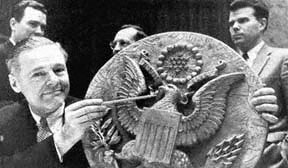The story of the electronic tollbooth begins at the turn of the century, in St. Petersburg, Russia. That's where Leon Theremin was born.

Yes, that Theremin — the creator of the musical instrument you play without even touching.
"Just as World War I was starting, and then the Russian Revolution, he found himself in the middle of that and was pulled into the new Soviet inner circle and told he was now a Soviet scientist," says Albert Glinksy, who wrote the biography Theremin: Ether Music and Espionage.
Playing with electromagnetic fields while working on a gas detection meter, Theremin discovered a trick: Using the radio frequency between two antennas, he'd wave one hand for volume and the other for pitch...
Theremin was sent to New York City, where he performed and continued to invent. But he also had another mission.
"He was carrying out espionage, so he had this sort of double life in New York," Glinsky says.
In 1938, Theremin returns to Russia.
But the political winds had changed, and he was sent to a Siberian labor camp, then transferred to a prison for scientists.
It was there that Theremin took spying to a new level when he was ordered to build
a bugging device to spy on the U.S. ambassador in Moscow.
"The brilliance of this device was it had no batteries, it needed no electrical external source," Glinsky says. "And it was perfectly inert until it was activated, when they wanted to externally, by microwave beams from a companion device that was a few buildings down."
The bug was the size of a quarter and placed in the office of the U.S. ambassador in Moscow. It was hidden in a seal of the United States, where it stayed for seven years before being accidentally discovered.
(Not true. It was found during a TSCM search.)
Theremin may have created the first RFID-like device. But it took a Brooklyn inventor to connect another technology — friend or foe radar — with modern computing that gets us to electronic toll collection.
more














